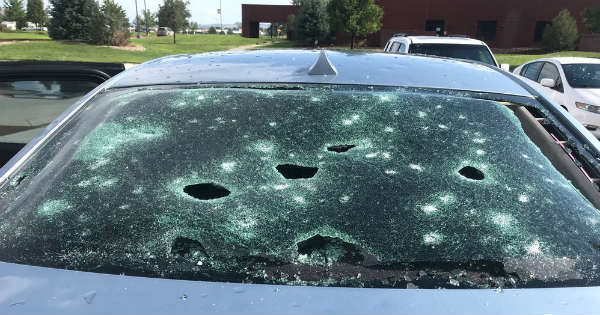Not all hail is guaranteed to damage your car. But, you should keep in mind that anything can happen and the risk is always there. For this reason, it’s a good idea to take necessary precautions, and – in the unfortunate event your car does get damaged by hail – let your insurer know. By doing so, they can visually assess your car and determine how serious the damage is. Although rare, it is possible for a hailstorm to cause so much damage, it renders a car as a ‘write-off.’ This decision is usually made by your car insurance provider. They may decide that, while the hail damage can be repaired, the cost for smash repairs would exceed the current market value of the car.

Therefore, it’s cheaper from the perspective of the insurance company to pay out your claim, giving you the necessary funds to buy a new car.
But just how severe must a hailstorm be in order to permanently damage your car? How does your insurer reach this conclusion? And what can you do to protect your car?
Keep reading to find out all of this, and more.
What exactly is hail?
Hail is a special type of water. It forms in the upper regions of thunderstorm clouds when drops of water freeze together. The ice can measure anywhere from 5mm up to 15cm or more. Hail can also be in a jagged or round shape.
Despite what you may think, hail is not really frozen rain. Frozen rain falls just like normal rain but eventually becomes solid before reaching the ground. Hail, on the other hand, is solid from the moment it falls from the thunderstorm clouds and stays that way until impact.
When is hail strong enough to write-off a car?
The amount of damage hail can cause depends on a range of factors. This includes the size (larger hail is more likely to cause damage), shape (jagged is deadlier), velocity (how fast the hail falls to the ground), and the wind speed. Any of these factors can increase the risk of hail damage.
Depending on the severity of the hailstorm, your car may suffer from cosmetic damage. This means the car has noticeable dents on the surface – be it on the hood, roof, boot, or anywhere else – but the damage is not severe enough to affect the vehicle’s safety or structural integrity. In essence, while your car now has a few visual imperfections, it’s still roadworthy and safe to drive.
How do you know when the vehicle is a write-off?
To find out, you need to have the vehicle inspected by a motor vehicle assessor. Your insurance company can arrange this service for you. Simply let your provider know that your car has suffered hail damage, and they’ll arrange a suitable day and time for the assessment.
After the assessment, your insurer will let you know if the car is repairable or a write-off. If the car is a write-off, it’ll be considered no longer safe to drive and recorded on the WOVR (Written-Off Vehicles Register). Once on this list, your vehicle cannot be removed from the list – ever.
Finally, your insurer will pay out the total value of your claim in accordance with the terms of your insurance policy.
Will my car insurance cover the hail damage?
That depends on the type of insurance you have and the terms of your policy. According to Compare the Market, most third party car insurance policies don’t cover hail damage. Why? Because these policies are designed to only cover the cost of damage to other vehicles and property – not your own.
Fortunately, most comprehensive insurance policies will cover you for hail damage. Of course, every policy is different. So be sure to review the terms of a policy carefully before you sign up. On top of this, some insurance providers require you to pay extra for hail damage cover, while others include this benefit at no extra cost.
What if your car has pre-existing hail damage?
As long as the car is not already a write-off, then you should be eligible for car insurance. However, your options may be limited to only third-party.
Why? Because, if the car was to incur further hail damage, it would be too hard for an assessor to know if the damage they’re seeing is new, or if it’s been there the whole time. Again, it depends on the state of your car.
How is hail damage repaired?
Most hail damage can be repaired by a qualified and experienced panel shop. By far, the most common type of repair job is a paint-less dent removal service. Here, a panel beater uses specialized tools and methods to smooth the metal back to its original position. There’s no risk of scratching or damaging the paint, so you don’t have to pay extra to repaint the panel. This way, the repair job is done quickly, and you keep more money in your pocket.
In more severe cases, where the hail damage has been strong enough to scratch or damage the paint, the panel shop will provide a customized quote to repair and/or repaint the entire panel.
Get Ahead Of The Storm
If you suspect a hailstorm is on the way, try to move your car to a safe space as soon as it is safe to do so. Virtually any area with a roof over your car will protect it from damage. Some great places to try include:
- Home garage or carport
- Under-cover car park
- Next to a large tall building (to protect your car from hail falling sideways due to extreme wind)
- Under a gas station canopy
- Under a tall bushy tree
Don’t have time to relocate your car? Throw some heavy blankets over it and tie them down. The thickness of the blankets might just be enough to cushion the blow of the hailstorm. Thus, saving you a trip to the panel shop.
Remember that vigilant ears can always avoid a calamity. Prevention is always the best cure and that applies to your vehicle as well. Keep yourself up-to-date with current weather projections and you won’t have to worry about repairing your car if you don’t need to.




